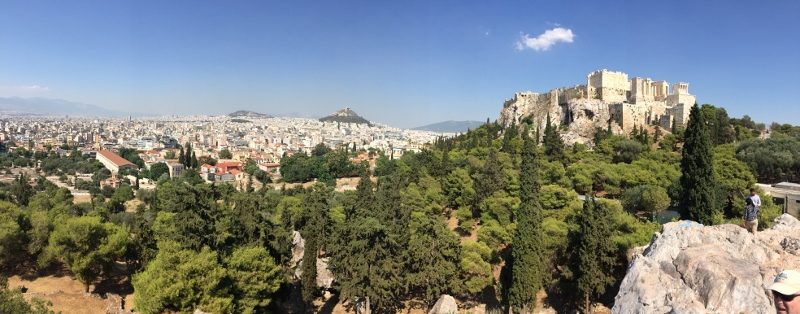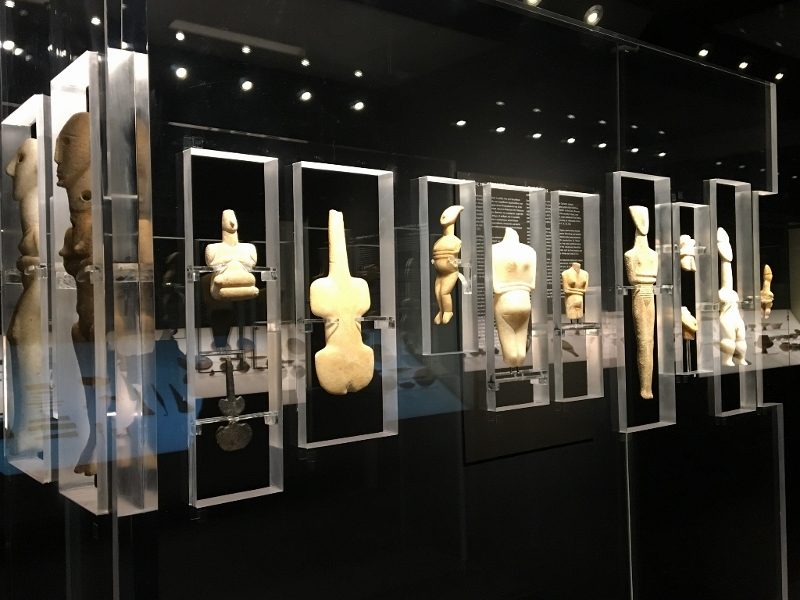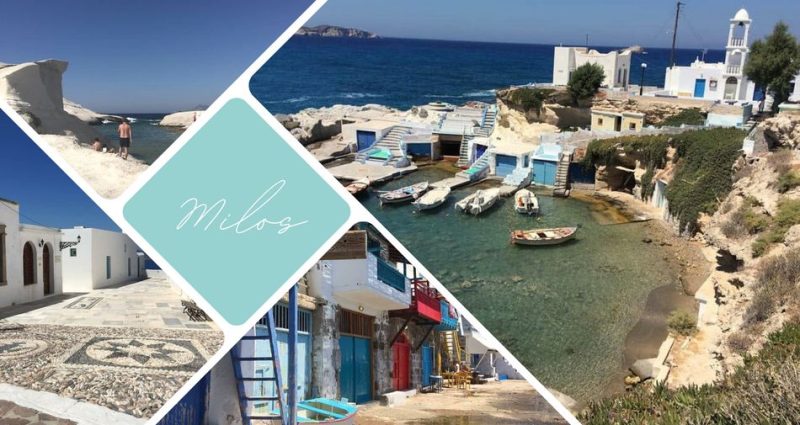Delos, a small arid granite island in the Aegean Sea, lies in the center of the Cyclades, opposite the tourist island of Mykonos. This uninhabited island, which rivals Delphi and Olympia in terms of archaeological importance , certainly offers the most varied collection of remains in Greece. In fact, the island of Delos is one of the 20 sites in Greece listed as a Unesco World Heritage Site!
Contents :
- Delos, the sacred island
- The legend of Delos
- The history of the island
- The delias
- The different monuments on the island of Delos
- The Delos Museum
- Visit Delos
You can also find practical tips for visiting Delos in our dedicated article.
To mark 150 years of excavations and studies on Delos, the French School of Athens is organizing an exhibition in its gardens until November 6, 2023, as well as a virtual exhibition until May 31, 2024.
Delos, the sacred island
All the Cycladic islands took their name from the Greek word “Kyklos” (circle) because they formed a circle around the sacred island of Delos. It’s true that the geographical position of Delos is privileged. The island lies halfway between the Greek mainland on one side and Ionia, Chios, Samos, Rhodes and Crete on the other.
The island of Delos covers an area of 3.43 km2, is 5 km long and 1.3 km wide. Its highest hill, Cynthe (Kynthos ), is 113 m high. And it’s crossed by the Inopos river, known since ancient times.
The legend of Delos
Legend has it that Delos was a piece of Sicily that wandered in the sea, half-hidden by the waves. Titanid Leto was looking for a place to give birth to the children she was expecting from Zeus – Apollo and Artemis. Zeus’ jealous wife, Hera, made every piece of earth disappear to prevent her from giving birth. Zeus asked Poseidon to find him a place where Leto could give birth in peace. So the god of the sea stirred the sea with his trident and made Delos appear in the middle of the Cycladic islands.
According to the Homeric hymn to Apollo (c. 700 BC), the wandering Leto found sanctuary in Delos. She gave birth under the care of the goddess Ilithye. Apollo and Artemis were thus born near a palm tree close to Cynthe and the course of the Inopos. The immense earth smiled and was covered with flowers; the universe was flooded with light.
Apollo subsequently became the island’s patron god , and Delos evolved into a powerful center of his cult.
It’s no coincidence that the ancients chose the island of Delos as Apollo’s birthplace. For everything on this island is bathed in light , from the first rays of dawn to the last of dusk. This light is not interrupted by the volumes of the high mountains or the silhouette of the trees. Sunlight is drawn to the ruined city, then reflected back to the visitor’s dazzled eyes.
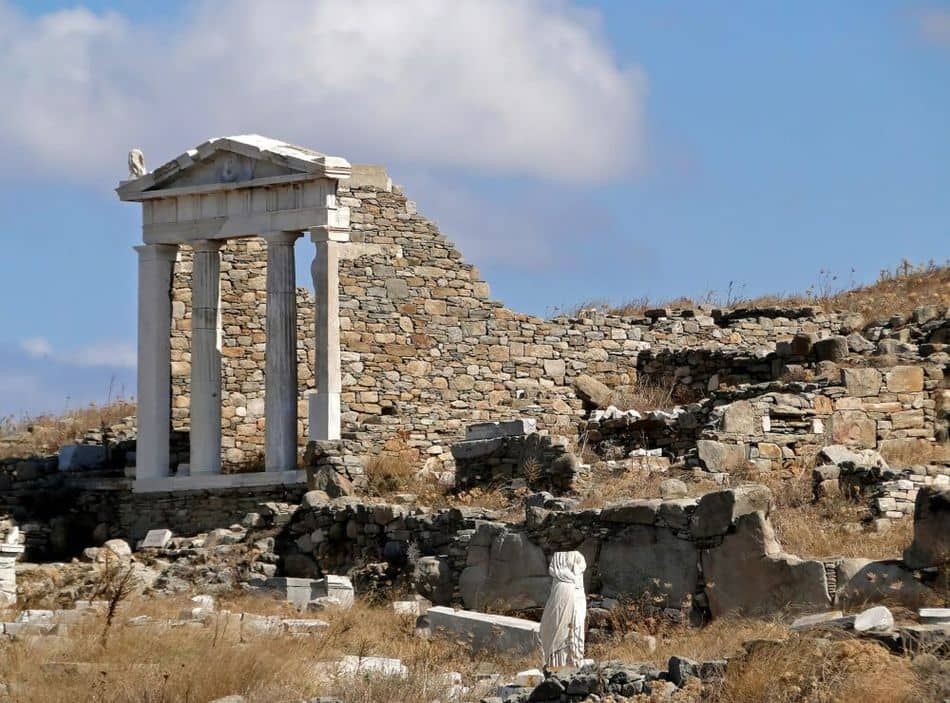
The history of Delos
Remains of circular huts bear witness to the first traces of occupation on Delos, dating back to the middle of the 3rd millennium B.C. But for the next ten centuries, there was no trace of human life.
During the second half of the 2nd millennium, in the Mycenaean period (1580-1200), Apollo’s sacred island flourished. Thanks to the security provided by Minoan domination at sea, a town spread across the plain. And around the port, important buildings were constructed.
Around 1100 BC, at the end of the Mycenaean period, the Ionians invaded the islands and eastern coasts of the Aegean Sea. Delos is then mentioned in the Odyssey and the Homeric hymn to Apollo, both written around 700 B.C., as a major religious center under the protection of the Ionians. Ships brought pilgrims and goods. Even then, Delos was developing into a major trading port. Delos became a religious center and received a large number of offerings. Several prestigious buildings adorn the sanctuary of Apollo.
In the 6th century, Paros and Samos marked their presence with numerous votive offerings. But it was above all Athens that had long sought to assert its supremacy over Delos, the Aegean islands and the Ionian cities. Athenian influence manifested itself under the tyrant Pisistratus, who purified the sanctuary of Apollo between 540 and 528 by clearing it of its tombs.
Against the Persians
After the Greek victory over the Persians, which was largely due to the Athenians, the latter secured their hegemony over the Greek cities by founding a new city in 478 BC. J. C. the first Athenian league. Delos was chosen as the seat of the Ionian amphitheatre, but under the direct control of Athens. The confederation gradually took the form of an empire ruled by the Athenians. And in 426 BC. J. C., Athens ordered another complete purification of the island. She was obeying an oracle that was said to have protected her from the plague that broke out during the Peloponnesian War. A decree forbade Delians to die or be born on the sacred island. All the graves were opened and their contents transported to Rhénée for burial in a common purification pit.
At the end of the 4th century BC, following the decline of Athens’ naval power, the Greek cities came under Macedonian domination. Under the reign of Antigone and his son, an island confederation was created, with Delos as its center. The island was proclaimed free and independent in 314 BC. J. C.
From the mid-3rd and early 2nd centuries B.C. onwards… J. C., the port of Delos opened up to large-scale trade. Located in the center of the Mediterranean, it became one of the main markets for cereals between Numidia, Asia Minor, Syria and Egypt. There was also an important slave trade. The island’s ancient sacredness is being lost. New divinities and new religions are emerging and flourishing.
Roman Delos
The Romans, victors over Macedonia, returned the island to the Athenians in 166 BC, granting it various commercial privileges to compete with Rhodes. This second Athenian domination began with the definitive expulsion of the Delians, who took refuge in Achaia while continuing to protest against the Athenians. The population of Delos now consisted mainly of poor Athenian settlers and middle-class citizens who had settled there as civil servants or merchants. In the second half of the 2nd century and early 1st century BC, Delos had a population of 25,000.
In 88 BC, Mithridates, King of Pontus, ravaged and plundered Delos in a war against Rome. He claimed 20,000 victims. When the Romans regained control of Delos, they surrounded most of the city with a rampart, including the sanctuary and the theater district.
The once very large town was considerably reduced in size at the beginning of the Christian era (2nd-5th c. AD). Delos was the seat of a bishopric on which the neighboring islands of Mykonos, Syros, Serifos and Kythnos depended. Several small Paleo-Christian basilicas were built using abundant ancient architectural materials.
In 727, Delos was pillaged by the Byzantine emperor Leon the Isaurian, in 789 by the Slavs, in 821 by the Saracens from Crete and then by the Arabs. Deserted and ruined, Delos fell into the hands of the Republic of Venice , who offered it to a lord from Mykonos. Delos and the neighboring island of Rhenaeus became known as Delos, and are still called Delos today. Little Delos for ancient Delos, Big Delos for Rhenaeus. The island remained unknown to Westerners until the Renaissance.
In 1873, the French School of Athens began systematic exploration of the island. The excavations have brought Delos back to life.
The delias
Religion is the source of Delos’ fortunes. The existence of a major city and a busy trading port can be explained by the many privileges enjoyed by the great sanctuaries. The first was inviolability. So, the merchants who had made Delos the first warehouse in the eastern Mediterranean placed themselves under Apollo’s protection to guarantee their businesses against pillage. Like all the great Panhellenic centers of worship, Delos attracted large numbers of pilgrims who came to attend the great religious festivals, the Delia.
The Delia festival was celebrated by the Athenians in Delos every four years in May. A ship carrying a hundred people from Athens to Delos. Disembarking on the island, the procession made its way to the temple, singing a hymn recalling the races of Leto and the birth of Apollo and Artemis. Gymnastic, equestrian and musical competitions were also held. The program ended with dramatic performances and banquets.
The different monuments on the island of Delos
In Delos, you’ll find all the elements of ancient life: a great Panhellenic sanctuary, a sacred cave and lake, a maritime and commercial city with harbors, quays, stores and merchants’ clubs, and a 2nd-century BC middle-class town.
There are four main groups of ruins on Delos:
- The religious city of Apollo or Hieron (sanctuary)
- The Sacred Lake region
- The Cynthe sanctuaries and the theater district
- The merchant port and small sanctuaries
The religious city of Apollo or Hieron
The northern end of Avenue des Processions opened onto a small square: the sanctuary of Apollon Delian (6th c. BC), where the god came to stay each spring during the summer months.
On the right, adjacent to the propylaeum, are the ruins of the Naxian Oikos (6th c. BC). The base of the colossal marble statue of Apollo still stands against the north wall of the Naxian Oikos. Dedicated by the Naxians, it bears an archaic inscription.
After the Portico of the Naxians, the ruins of a temple built by the Athenians lead us to believe that this may have been the Keraton, the building housing the Naxians, the altar of horns built, according to legend, by Apollo from the horns of his victims, and in front of which, during the Delia festival, the crane dance was performed.
We then move on to the high granite foundations of the temple of Artemis, dating from 179 BC. Although part of the sanctuary of Apollo, the Artemision formed a separate complex.
In the eastern part of Apollo’s Hieron, a single building, much longer than it is wide, stretches out, known as the Sanctuary of the Bulls.
We leave the Hieron of Apollo and head towards the Sacred Lake area, passing by the agora of Theophrastus.
The Sacred Lake region
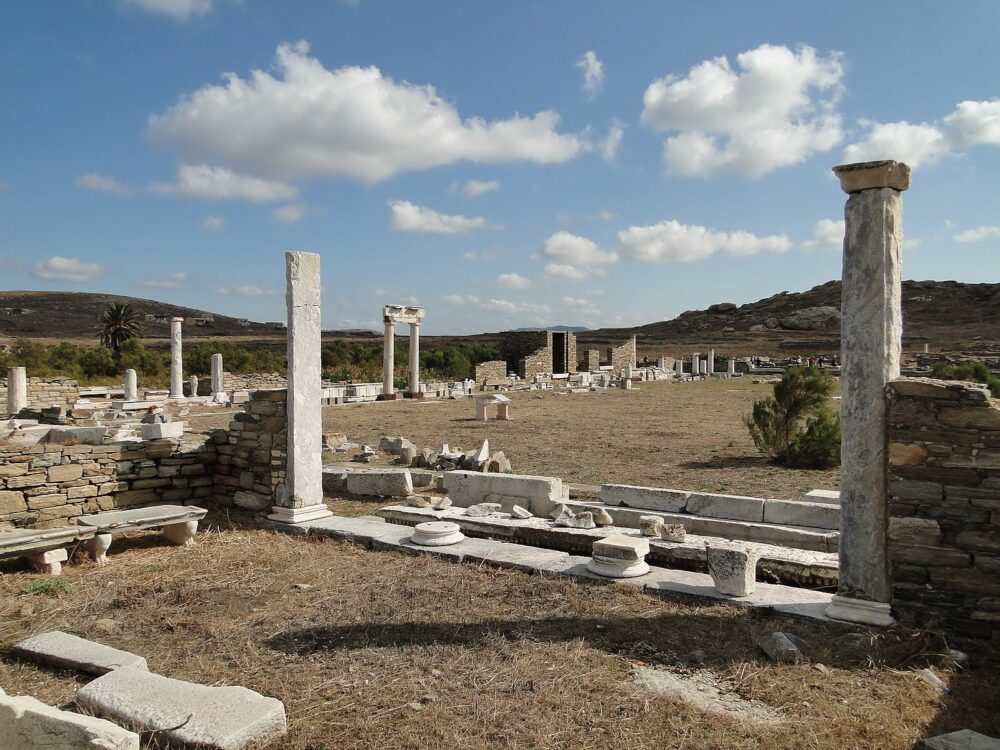
Theophrastus’ Agora was built in the second half of the 2nd century BC. J. C. by the Athenian Theophrastus, who laid out the square. Nearby was a large hall called the Portico of Poseidon (3rd c.), built to serve as a stock exchange or meeting room for merchants. The temple next door is where Leto, mother of Apollo and Artemis, was worshipped.
Opposite this building, through a propylaeum with 4 Doric columns, was “the Italian Agora”, built by private individuals to serve as a meeting place for the island’s Italian colony, which had grown in importance by the end of the 2nd century. av. J. C. This monument, the most spacious on Delos, consisted of a central courtyard surrounded by four Doric porticoes on the Ionic floor.
To the north of the Agora lay the Sacred Lake, now filled in, but whose elliptical shape can be recognized by the modern wall that surrounds it. In the Lake lived the swans of Apollo and the sacred geese of Hieron.
The Lions
On the west side of the lake, a 50m-long terrace overlooking the street and the lake bore a row of at least 9 archaic lions in Naxos marbl. The Naxians had consecrated them to symbolically guard the lake. Of these lions standing on their pedestals facing the Sacred Lake, five were found in place. Another was taken away at the end of the 17th century and now stands at the entrance to Venice’s arsenal. These lions are the island’s most impressive and best-known sculptures.
On the north side of the lake, we come to the House of Diadumene, so called because it contains a replica of the famous work by the Argian sculptor Polyclitus (circa 420 BC). A copy of this statue is on display at the National Archaeological Museum in Athens. In the house known as the Comedians, a frieze painted in seven small pictures, depicted comic and tragic actors. In the house known as the Tritons, a mosaic pavement depicts a woman with a fish tail and an eros above. Also on the same block are the Hill House and the Lake House.
Stadium area
If you have a little time to spare, take the path between the Triarius wall and the Agora des Italiens to the stadium area.
The first building is an archaic sanctuary dating from the 6th century. av. J. C. This is the Archegesion, dedicated to Anios, son of Apollo, legendary founder and first king of Delos. Continuing eastwards, you’ll be impressed by the imposing ruins of the Gymnasium. Dating from the 3rd century BC, this building comprises a large square courtyard surrounded by four porticoes with thirteen columns.
To the north-east of the Gymnasium is the 182 m-long stadium. Along the west side are the bleachers where spectators used to sit. To the east of the stadium, along almost its entire length, is the stadium district.
The building to the south-east, close to the sea, has been identified, thanks to the inscriptions collected, as a Synagogue.
The Cynthe sanctuaries and the theater district

Bernard Gagnon, CC BY-SA 3.0
From the Agora des Competaliastes, a path leads up to Cynthe, leaving the theater district on the right. On the first slopes, after a shrine to Aphrodite on the right, you come to the house of Inopos. A 22-step staircase led to a reservoir that captured the waters of the Inopos, a torrent on the northern flank of Cynthe, mentioned in the Homeric hymn of Apollo. To the west of the reservoir, in a vast residence known as the House of Hermes, excavations unearthed a Hermes head.
Further away from the Inopos house, a staircase leads up to the badly damaged Sarapeion B. The next sanctuary was dedicated to the Cabires, deities of Samothrace. Another staircase led to the long terrace of the foreign gods (Syrian and Egyptian divinities). To the south, Sarapeion C was the most important of the island’s three Egyptian sanctuaries. To the east of Sarapeion C, on a terrace, stood the Heraion or temple of Hera, a divinity worshipped in Delos from the early 7th century.
Heraion terrace
A path from the Heraion terrace leads to the summit of Cynthe (112.60m), from where there is an admirable view of the Cyclades.
From the Cynthe, descend to the Heraion terrace, to reach the theater district. The Dolphin House is adorned with a mosaic of dolphins ridden by sweethearts. Then we’ll visit the house of masks. In this house, there was a courtyard with a basin for collecting rainwater, surrounded by a peristyle with four columns on each side.
The theater (built shortly after 250 B.C.) could seat around 5,500 spectators. From the theater, two streets led down to the sanctuary of Apollo and the port. The paved rue du théâtre, with its sewer, was lined with houses, stores and more.
There are two more houses to visit. The Trident house, whose peristyle is adorned with a mosaic depicting a trident and anchor, with a dolphin next to it. In Cleopatra’s house, on the same base, stood the statue of Cleopatra, an Athenian, and that of her husband, Dioscourides (2nd c. BC). Almost opposite is the House of Dionysus, adorned with a mosaic depicting Dionysus, thyrseus in hand, riding a panther.
The merchant port district
From the Agora des Competaliastes, head south along the seafront. We then walk along a group of stores backing onto the theater district. Continuing south, we soon come across a second group of stores. There was no direct communication between the warehouses and the city district behind them. This was almost exclusively a transit trade. Goods from Tyre or Alexandria were immediately shipped back to Italy.
According to Strabo, the Delos market was abundantly supplied with slaves. The slave trade flourished between the 2nd and 1st centuries BC. J. C. Around 130 BC J. C., there was a major slave revolt on the island. Construction of the Agora des Italiens began just after this revolt. It had two particularly narrow entrances, with additional surveillance and security facilities. The whole architectural plan leads us to assume that this building was intended to gather together a large number of people for a short period of time, in times of major disruption.
We then reach Phourni Bay, with a beautiful beach recommended for bathing and sheltered from the north wind. The ruins of the sanctuary of Asclepius can be found on the rocky promontory that protects it to the north-west.
Rhenee (Rhinia) or the great Delos
The island is now deserted. It served as a necropolis for the Delians and a refuge for women about to give birth.
On the seafront, below the chapel of Haghia Kyriaki, the necropolis where the Athenians, after the purification of Delos in 426, deposited the remains exhumed from the Sacred Island, has been found. It’s a 500m2 enclosure surrounded by a wall and divided into small rectangular compartments.
The Delos Museum
The Museum contains most of the antiquities discovered on the island, except for the most remarkable statues, which have been transferred to the National Archaeological Museum in Athens.
Central hall
The middle room features archaic sculptures. Note :
- The Euthykratides base. This triangular base supported a kouros, contemporary with the Naxian colossus. The dedication on the base tells us the name of the sculptor.
- Torsos and fragments of kouroi and korês among the earliest known (7th c. BC), as well as more recent ones (6th c. BC).
- The sphinx. Parian work from the middle of the 6th century. av. J. C. Ex-votos of this type were quite common in the great sanctuaries of antiquity. The most famous was the Sphinx of the Naxians at Delphi.
North Hall
This room contains works of sculpture from the 5th century. av. J. C. Fragments of acroteria groups from the Temple of the Athenians and several torsos of young athletes stand out.
South Hall
This room contains a large number of vases and small objects uncovered during the excavations. The finds are dated between prehistoric times and the 4th century BC. J. C.
The Museum houses many of the most representative sculptures of Hellenistic plastic art: Apollo treading on Galatian shields; Poseidon, a copy of a work from the School of Lysippus; Artemis with a doe; Head of a dying Gaul; Head of bearded Hermes.
However, the collection of the Delos Museum is considerably smaller than that of the Mykonos Museum.
Visit Delos
How to get to Delos Rates, opening hours, practical advice…. We explain everything in detail in our article Visiting Delos in Greece: practical tips and information.
You can now book your boat ticket from Mykonos to Delos on Get Your Guide or Civitatis (cancellable and refundable). Take advantage of the crossing from Mykonos to relax and use the same ticket for the return trip.
Finally, if you’re looking for a guided tour of Delos, we’ve spotted this tour on the GetYourGuide website. We haven’t tested it (yet), but it looks interesting.
Mania F.

